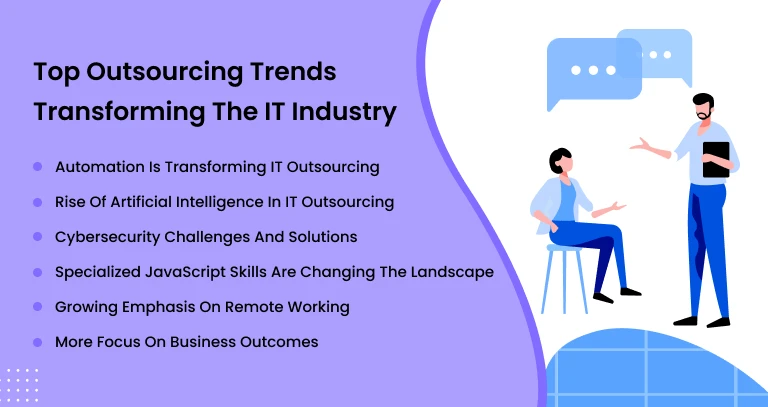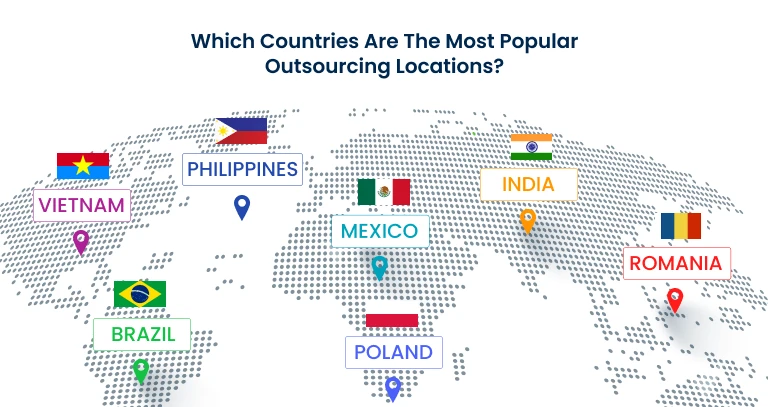IT Outsourcing is a business model in which a company outsources some or all of its IT functions to an external provider. This allows companies to focus on their core business and save costs associated with hiring and training staff, maintaining hardware and software, etc. Outsourcing IT functions also helps companies stay competitive in the market as they can access specialized skills and techniques that may not be available within the organization. Let’s discuss Top IT Outsourcing Trends in 2023.
Why is IT Outsourcing Gaining Popularity?
The popularity of IT Outsourcing has grown in recent years due to its cost-effectiveness and scalability. Companies no longer need to recruit additional staff or invest in expensive technology, as the service provider can take care of all these tasks for them. Furthermore, outsourced services can be tailored according to the specific needs of each organization and allow them to increase productivity while reducing operational costs.
This blog is devoted to helping businesses stay up-to-date on the latest trends in IT outsourcing. It provides valuable insights into how companies are leveraging the advantages of outsourcing their IT needs, as well as exploring the potential pitfalls and challenges that come with it. this blog seeks to help businesses make better decisions when it comes to managing their technology needs.
Importance of Staying Ahead of IT Outsourcing Trends
Staying ahead of IT outsourcing trends is essential for businesses to remain competitive in today’s digital world. With the rapid evolution of technology, businesses need to be able to adapt quickly and efficiently to changes in the IT outsourcing market. By staying ahead of the curve, businesses can take advantage of new opportunities and minimize risks associated with outsourcing projects. Additionally, staying up-to-date with IT outsourcing trends can help businesses reduce costs and maximize efficiency by leveraging the latest technologies. With an understanding of current developments in the IT sector, businesses can make informed decisions about which services are best suited to their needs and budget.
4 Stages of Outsourcing
Outsourcing isn’t a one-size-fits-all solution; it’s a strategic process consisting of four distinct stages that demand careful planning and execution. Let’s dive right in!
1. The Discovery Phase: Finding Your Outsourcing Sweet Spot
The first stage of outsourcing is like setting sail on an uncharted sea. You need a clear map to navigate through the waters successfully. Here’s what you should do:
Identify Your Objectives
Before you start outsourcing, you must define your objectives. What are you looking to achieve through outsourcing? Cost reduction, increased efficiency, access to specialized skills, or all of the above? Clearly outlining your goals is your North Star in this journey.
Analyze Your Business Processes
Once you’ve set your objectives, take a deep dive into your existing business processes. Which tasks can be streamlined or delegated? By identifying these areas, you’ll gain insights into what can be outsourced.
Budget and Cost Analysis
Outsourcing can be cost-effective, but only if you manage your finances wisely. Calculate your budget and assess the potential cost savings. Remember, it’s not just about the price tag; it’s also about the value you’ll gain.
Choose the Right Outsourcing Partner
Selecting the right outsourcing partner is crucial. Research potential partners thoroughly, considering factors like their expertise, reputation, and cultural fit. Don’t rush this step; it can make or break your outsourcing endeavor!
Define Key Performance Indicators (KPIs)
To measure the success of your outsourcing venture, establish clear KPIs. These metrics will help you track progress and make informed decisions along the way.
2. The Transition Phase: Making the Leap
With your objectives clear and your outsourcing partner selected, it’s time to make the leap. This phase involves the actual transition of responsibilities. Here’s how to do it smoothly:
Create a Transition Plan
A well-thought-out transition plan is your lifeline during this stage. It should outline the timeline, roles and responsibilities, and communication protocols. Ensure that everyone is on the same page.
Communication is Key
Effective communication is vital during the transition phase. Keep the lines of communication open with your outsourcing partner, internal teams, and stakeholders. Address concerns promptly and proactively.
Training and Onboarding
If your outsourcing partner requires specific training or onboarding, provide it diligently. A seamless transition hinges on their understanding of your business processes and expectations.
Monitor Progress
Keep a watchful eye on the progress of the transition. Are tasks being handled as expected? Are there any hiccups that need immediate attention? Regular check-ins and status reports can help you stay on top of things.
3. The Integration Phase: Weaving Outsourcing into Your DNA
Once the transition is complete, it’s time to weave outsourcing into the fabric of your organization. Integration is about creating synergy between your in-house team and your outsourcing partner:
Establish Collaboration Tools
Invest in collaboration tools that facilitate seamless communication between your team and the outsourced team. Video conferencing, project management software, and shared documents are your best friends here.
Define Roles Clearly
Clear role definitions are essential to avoid confusion and duplication of efforts. Everyone should know their responsibilities and how they contribute to the bigger picture.
Cultural Integration
If your outsourcing partner is in a different location or has a different cultural background, cultural integration is key. Foster a sense of unity and shared purpose among all team members, regardless of their physical location.
Continuous Improvement
The integration phase is an ongoing process. Continuously evaluate the effectiveness of your outsourcing arrangement and make improvements as needed. Adapt to changing circumstances and market conditions.
4. The Optimization Phase: Maximizing the Benefits
Congratulations, you’ve successfully navigated the first three stages of outsourcing! Now, it’s time to reap the rewards and fine-tune your outsourcing strategy for maximum benefits:
Performance Evaluation
Regularly assess the performance of your outsourcing partner against established KPIs. Are they meeting your expectations? Are there areas for improvement? Use data-driven insights to guide your decisions.
Streamline Processes
The optimization phase is the perfect time to streamline your processes further. Identify bottlenecks and inefficiencies and work with your outsourcing partner to find solutions.
Explore Expansion
If your initial outsourcing efforts have yielded positive results, consider expanding your outsourcing portfolio. This could involve outsourcing additional tasks or even entire business functions.
Stay Agile
The business landscape is constantly evolving. To stay competitive, you must remain agile. Be prepared to pivot and adapt your outsourcing strategy as needed to align with your business goals.
Top IT Outsourcing Trends to Watch in 2023

IT outsourcing is one of the most important aspects of software development. In the coming years, there will be a number of trends that are likely to shape the IT outsourcing landscape in 2023. This article will focus on some of these trends and discuss why they are important for businesses looking to outsource their IT needs. We’ll also look at how these trends could impact current and future IT outsourcing strategies. By understanding these trends, businesses can ensure that they make informed decisions when it comes to their IT outsourcing needs.
-
Automation is Transforming IT Outsourcing and providing Significant Cost Savings:
Automation has been transforming the IT outsourcing industry for years. Automated IT services are becoming increasingly popular as they provide significant cost savings, enhance the quality and scalability of IT services, and reduce manual labor. Automation is transforming the entire industry, from offering personalized customer service to providing innovative solutions in a much faster timeframe.
Automation has been identified as one of the top outsourcing trends for 2023, allowing organizations to reduce costs and increase efficiency by offloading tedious tasks such as patching and maintenance. Companies are turning to automated solutions such as robotic process automation (RPA) and artificial intelligence (AI) to automate mundane and repetitive tasks for their teams. These tools can help businesses save time, money, and resources while also increasing accuracy and productivity levels across their teams. As automation continues to become more prevalent in the IT space, we can expect to see more companies adopting automated solutions that will revolutionize the way they do business in 2023 and beyond.
Overall, automation is enabling businesses to get more value from their IT outsourcing investments by reducing costs and improving services.
-
The Rise of Artificial Intelligence in IT Outsourcing
Artificial Intelligence (AI) is one of the fastest-growing trends in IT services today. The use of AI has been increasing rapidly in various industries and it offers a number of advantages over traditional outsourcing. AI enables companies to outsource more complex and time-consuming tasks while saving money and improving efficiency.
It is predicted that by 2023, the majority of outsourcing services will include some type of AI technology. This trend is due to the fact that AI can be used for a range of tasks, from data analysis to customer service automation. By utilizing AI for IT Outsourcing, businesses can benefit from increased accuracy and faster turnaround times when completing projects or tasks. Furthermore, AI can help provide insights into how improvements can be made to the quality and speed of services provided by outsourced teams.
Benefits of AI in the IT Industry:
- One of the main benefits of AI in IT services is its ability to automate repetitive tasks and processes, freeing up employees to focus on more strategic and higher-value work.
- AI can also help businesses personalize customer interactions and experiences, leading to improved customer engagement and loyalty.
- AI can also be used for predictive maintenance and fraud detection, it can predict when equipment is likely to fail and prevent fraudulent activity by identifying patterns that might indicate fraudulent activity.
- Another way AI can benefit your business is through the use of chatbots, which are AI-powered virtual assistants that can provide instant support to customers 24/7.
Overall, the rise of AI in IT services is enabling businesses to improve efficiency, accuracy, and customer engagement while reducing costs. It is a powerful tool that can help businesses stay competitive and meet the changing demands of the digital age.
-
CyberSecurity Challenges and Solutions for Outsourced IT Services
With the rise in outsourcing trends, IT Outsourcing has become a major trend for businesses in 2023. Outsourcing IT services can offer cost savings and access to expertise, but it also presents some data security and privacy challenges.
By 2023, outsourcing IT services will be an integral part of improving cybersecurity for many businesses. Outsourcing IT services to experienced professionals can help identify and address potential security threats before they cause any damage. It can also provide access to better technology and tools that will help protect an organization from cyber-attacks. Furthermore, outsourcing allows businesses to focus on their core operations while receiving the expertise needed to keep their data secure.
In the year 2023, outsourcers are utilizing new cutting-edge technologies to secure client data. Innovations such as blockchain technology and encryption algorithms provide a secure platform for businesses to store and protect their data. Other security measures such as two-factor authentication, biometric authentication, and zero-knowledge proofs are providing added protection against hackers and other malicious actors. Outsourcers are taking advantage of these technologies to ensure that client data is kept safe in the digital age.
-
Specialized JavaScript Skills Are Changing the Landscape of IT Outsourcing
Specialized JavaScript skills are transforming the face of IT Outsourcing. JavaScript has become an essential language for developing software applications and websites, as it is both versatile and easy to learn. With its powerful capabilities, developers can create custom-made solutions that are tailored to their client’s needs. This allows companies to outsource complex tasks while reducing costs and timeframes associated with them. It also opens up exciting possibilities for the future of IT Outsourcing.

The popularity of JavaScript frameworks such as React, Node, Angular, and Vue has made it easier for companies to outsource web development projects as these frameworks have a large community and a wealth of resources available to developers. This has increased the availability of skilled developers in these frameworks and made it easier for companies to find the right talent for their projects.
Additionally, the rise of Node.js has enabled developers to use JavaScript for both front-end and back-end development, further increasing the demand for skilled JavaScript developers.
Overall, the increasing demand for specialized JavaScript skills is changing the outsourcing landscape by making it more competitive and challenging for companies to find cost-effective outsourcing options. However, it also opens up new opportunities for countries and companies with a specialized and skilled workforce in these areas.
-
Increasing Demand Among Startups for Outsourced IT Services
Outsourcing IT services is becoming increasingly popular among startups. This is due to the fact that it provides them access to a wide range of skills, cost savings, and faster delivery times.
The demand for outsourcing IT services will continue to grow in 2023 as startups look for ways to expand their operations quickly and efficiently. They are looking for ways to get the most out of limited resources while ensuring high-quality results. As such, they are increasingly turning towards external experts and service providers to provide them with the right tools and services they need.
Moreover, outsourcing IT services helps startups overcome challenges related to technology, resources, and cost constraints. By leveraging the expertise of third-party vendors, they can get access to advanced tools and techniques at an affordable rate that can give them an edge over their competitors in a fast-paced market environment.
-
Growing Emphasis on Remote Working
Remote work has become increasingly popular in recent years, and it looks like this trend is here to stay. Companies will need to have a plan in place for securely managing IT services and operations. This means using the right tools, strong security measures, and reliable remote access technology to ensure the safety of their data. It also means developing strategies for managing and hiring remote teams effectively and providing them with the resources they need to succeed. With the right plan in place, companies can ensure that their employees remain productive while working remotely.
In 2023, it is estimated that 30% of companies will have a majority or all of their employees working remotely. This means the responsibility to make sure IT services are secure and reliable falls on the shoulders of remote workers themselves.
-
More Focus on Business Outcomes From Outsourcing
Companies are increasingly looking to outsource services that will help them achieve specific business outcomes. This shift towards outcome-based models is driven by the need for greater efficiency, cost savings, and a more streamlined approach to operations. By outsourcing certain services or projects, companies are able to focus on their core competencies while still achieving desired outcomes. Outcome-based models also allow for greater flexibility and scalability than traditional IT service models.
What Are the Benefits and Challenges of Outsourcing?
Outsourcing is a popular business strategy that allows companies to access specialized skills, reduce operational costs, and improve efficiency. It involves contracting out certain tasks or processes to external vendors or contractors. The main benefit of outsourcing is that it allows companies to focus on their core competencies while leaving the rest of the work to an expert. However, there are some challenges associated with outsourcing that businesses should be aware of before they make the decision to outsource. These include issues such as communication difficulties, cultural differences, and lack of control over the quality of services provided by external vendors. In this article, Let’s explore the benefits and challenges associated with outsourcing so businesses can make an informed decision about whether or not it’s right for them.
The benefits of outsourcing can include:
- Cost savings: Outsourcing can help companies reduce labor costs and overhead expenses.
- Access to specialized expertise: Outsourcing providers often have specialized expertise that can be difficult to find in-house.
- Increased efficiency and productivity: Outsourcing can help companies focus on their core competencies and business objectives while outsourcing non-core functions to experts.
- Flexibility: Outsourcing can allow companies to quickly scale up or down depending on business needs.
- Improved service and quality: outsourcing providers are likely to have the latest technology, tools, and best practices to deliver high-quality services and products.
The challenges of outsourcing can include:
- Communication and cultural barriers: Language and cultural differences can make communication and coordination with outsourcing providers difficult.
- Loss of control: Outsourcing certain functions can make it harder for companies to maintain control over the quality and delivery of services or products.
- Risk management: Companies must ensure that outsourcing providers have the necessary security and compliance measures in place to protect sensitive data.
- Dependence on the provider: Companies can become too dependent on the outsourcing provider, which can make it difficult to terminate the relationship if the provider is unable to meet the company’s needs.
- Quality control: it’s difficult to ensure quality control when outsourcing, which may lead to issues with the final product or service.
What are the Best Practices For Selecting an IT Outsourcing Partner?
Outsourcing your business’s IT needs can be a great way to get the best possible results while also reducing costs. With the right partner, you can gain access to modern technologies, expert resources, and cutting-edge outsourcing trends that will help your business stay competitive in the digital age. However, with so many potential IT outsourcing partners available, it’s important to be mindful of best practices for selecting an IT Outsourcing Partner. This includes considering factors such as cost-effectiveness and scalability of services, as well as researching their history and customer reviews. In this article, we will discuss some of the key trends in IT outsourcing for 2023 and provide tips on how businesses should go about selecting an IT Outsourcing Partner that meets their needs.
In a recent report published by Gartner, they predict that by 2023, over 90% of global businesses will be utilizing some form of IT outsourcing. This is largely due to the fact that businesses are recognizing the benefits and finding it easier to outsource their IT needs. What they’re also discovering is that as technology continues to advance at an exponential rate, companies that choose not to outsource their IT could fall behind quickly in the market. There are many factors in play when considering whether or not a business should outsource its IT needs.
- Clearly define project scope and goals: Before beginning the outsourcing process, companies should clearly define the scope of the project and the specific goals they hope to achieve through outsourcing.
- Conduct a thorough vendor selection process: Companies should conduct a thorough vendor selection process that includes evaluating the vendor’s experience, qualifications, and references.
- Establish clear communication channels: Companies should establish clear and open lines of communication with the outsourcing provider to ensure that all parties are on the same page and to facilitate problem-solving as issues arise.
- Understand the provider’s security and compliance measures: It’s important to understand the provider’s security and compliance measures and ensure they meet the company’s needs.
- Establish Service Level Agreement(SLA): Establishing a service level agreement (SLA) that clearly defines the responsibilities of both parties, including service level expectations and key performance indicators, can help ensure that the outsourcing partnership runs smoothly.
- Regularly evaluate performance: Companies should regularly evaluate the performance of the outsourcing provider to ensure that the provider is meeting the company’s needs and that the partnership is achieving the desired results.
- Have a clear exit plan: It’s important to have a clear exit plan in place in case the outsourcing partnership doesn’t work out. This can help ensure a smooth transition if the company needs to terminate the relationship.
- Consider the location and time zone: if the outsourcing provider is located in a different time zone, it’s important to consider the potential impact on communication and coordination.
Which Sectors and Functions Are Outsourced The Most?
Outsourcing has become a popular way for businesses to reduce costs and increase efficiency. It involves the transfer of certain functions or processes to an external provider, allowing companies to focus on their core competencies and gain access to specialized skills.
The most commonly outsourced functions include customer service, accounting, finance, IT services, human resources, marketing, and advertising. Many organizations outsource these tasks in order to reduce costs by taking advantage of the lower labor costs in other countries. Additionally, outsourcing allows them to benefit from the expertise of professionals who specialize in these areas.
In terms of sectors that are outsourced the most, manufacturing is one of the biggest users of outsourcing services due to its global supply chain needs. Other sectors that often outsource include healthcare, transportation, retail, and hospitality. With more companies turning towards outsourcing for cost-effectiveness and efficiency gains, it is likely that this trend will continue into the future.
Which Countries Are the Most Popular Outsourcing Locations and Why?

Outsourcing has become a popular way for businesses to access skilled labor at a more competitive rate. Companies can now outsource their work to countries with lower costs of living, allowing them to save money while still getting quality work done.
The most popular outsourcing locations are those with the highest availability of skilled workers and the lowest costs of living. This includes countries like India, China, the Philippines, Vietnam, and Romania. These countries have large populations and are known for having highly skilled professionals who can provide quality services at competitive rates. Additionally, they have well-developed infrastructure and reliable internet connections which make it easier for businesses to communicate with their remote teams.
Outsourcing is becoming increasingly popular as it allows companies to focus on their core business activities while still getting high-quality work done in an efficient manner. By choosing the right outsourcing location, businesses can benefit from cost savings while still receiving top-notch results from their remote teams.
Conclusion:
In conclusion, IT outsourcing is a rapidly evolving field, and the trends of 2023 will be shaped by a number of factors, including the ongoing impact of the pandemic, the rise of automation and AI, and the ongoing shift to cloud-based services. Companies that stay informed about these trends and position themselves to take advantage of them will be well-positioned for success in the coming year and beyond. In 2023, we can expect to see an increase in the use of automation and AI in IT outsourcing, as well as a growing emphasis on remote and cloud-based services. Companies will also need to pay close attention to cybersecurity, as the shift to remote work and increased use of cloud-based services will present new vulnerabilities. By staying informed and taking a strategic approach, companies can leverage these trends to improve their operations and achieve success in the years to come.
Partner With Us for Success
Don’t miss out on the numerous benefits that IT outsourcing can offer your company. By outsourcing IT functions, you can achieve cost savings, improved efficiency, access to specialized expertise, and greater flexibility. Take the first step towards realizing these benefits by evaluating the current IT outsourcing trends and considering how they can be leveraged to improve your operations. Contact us today to learn more about how we can help you achieve success through IT outsourcing.
FAQ’s
1. What are the main benefits of IT outsourcing?
In 2023, IT outsourcing offers several key benefits:
- Cost savings through economies of scale.
- Access to a global talent pool.
- Scalability to meet changing business needs.
- Reduced time-to-market for IT solutions.
- Focus on core business activities while experts handle IT operations.
2. Is IT outsourcing secure in the age of cyber threats?
IT outsourcing can be secure if the right cybersecurity measures are in place. Businesses should prioritize robust security practices, including encryption, regular assessments, and employee training.
3. How can small businesses compete with larger enterprises in IT outsourcing?
Small businesses can compete by focusing on niche areas where they excel, leveraging their agility, and forming strategic partnerships with IT outsourcing providers that understand their unique needs.
4. What should I look for in an IT outsourcing partner?
When choosing an IT outsourcing partner, consider their expertise, track record, cybersecurity measures, sustainability practices, and cultural alignment with your organization. Communication and transparency are also crucial factors.



